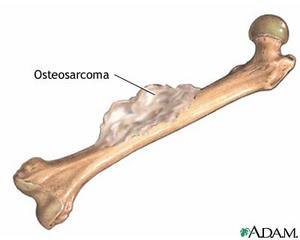Bone Cancer - symptoms, prognosis, treatment and survival rate

What is Bone Cancer and Definition
Cancer that occurs in the tissues of the BONE, either as primary cancer (cancer that originates in the bone) or metastatic cancer (cancer that spreads to the bone from an origin elsewhere in the body). Primary bone cancer is rare; doctors in the United States diagnose about 2,500 people with primary bone cancer each year. Its three forms are
- osteosarcoma, which arises from osteoid (the formative tissue of new bone) usually in the upper leg or upper arm in young people ages 10 to 25
- Ewing’s SARCOMA, which results from a TRANSLOCATION GENE MUTATION and generally arises from the long bones (and occasionally soft tissue structures) during ADOLESCENCE
- chondrosarcoma, which develops in the cartilage of the shoulders or pelvis in adults over age 50
Osteosarcoma accounts for about a third of primary bone cancers. RADIATION THERAPY for other cancers increases the risk for osteosarcoma. Though primarily a cancer of childhood, osteosarcoma sometimes occurs in older adults. Oncologists (cancer specialists) often stage primary bone cancer only as localized (one contained site) or metastasized (spread to multiple sites).
The bone is a common site for cancer that metastasizes from other sites in the body such as the BREAST, PROSTATE GLAND, and COLON. Metastatic cancer retains the name of its original site. Multiple myeloma, a cancer of the BLOOD, also affects bone structure though is not a true bone cancer.
Symptoms of Bone Cancer and Diagnostic Path
The main symptom of bone cancer is PAIN, usually at the site of the tumor. The pain may be present for several months before becoming intense enough for the person to seek treatment, or may develop suddenly. Sometimes the first indication of bone cancer is a FRACTURE, either spontaneous (without trauma) or as a consequence of minor trauma that would not fracture healthy bone. The diagnostic path typically begins with X-rays, which can show most bone cancers. COMPUTED TOMOGRAPHY (CT) SCAN, MAGNETIC RESONANCE IMAGING (MRI), and radioisotope bone scan can provide greater detail about the tumor to aid in its diagnosis. POSITRON EMISSION TOMOGRAPHY (PET) SCAN can detect whether or to what extent the cancer has metastasized to other sites in the body. A blood test to measure the level of alkaline phosphatase, an enzyme osteoblasts release when configuring new bone tissue, may suggest—though cannot confirm—bone cancer. Blood levels of this enzyme are normally high during periods of bone growth. Biopsy of the tumor provides the definitive diagnosis.
Bone Cancer Treatment Options and Outlook
Treatment depends on the location and size of the tumor. Treatment options for primary bone cancers include CHEMOTHERAPY, radiation therapy, and surgery to remove the tumor. Often, radiation therapy or chemotherapy administered first can shrink the tumor so the surgeon can remove it without the need to amputate the involved limb. Oncologists often administer chemotherapy both before and after surgery. The course of chemotherapy before surgery is typically 8 to 10 weeks; chemotherapy after surgery may extend for a year. The oncologist is likely to add radiation therapy to the treatment regimen when there are metastases the surgeon cannot safely remove. Treatment for metastatic cancer of the bone depends on the type of primary cancer and the degree of METASTASIS.
The outlook after treatment depends on the extent of cancer present at the time of diagnosis. Significant surgery, such as AMPUTATION, requires intensive rehabilitation. The outlook for metastatic cancer of the bone depends on the type of primary cancer and the aggressiveness of metastatic disease.
Bone Cancer - Risk Factors and Preventive Measures
Though Ewing’s sarcoma has a clear genetic connection, doctors know little about the risk factors for and causes of other forms of primary bone cancer. Radiation exposure, such as radiation therapy to treat a different cancer, increases the risk for osteosarcoma. There are no measures known to prevent bone cancer.
See also BREAST CANCER; CANCER TREATMENT OPTIONS AND DECISIONS; COLORECTAL CANCER; PAGET’S DISEASE OF THE BONE; PROSTATE CANCER; SURGERY FOR CANCER.
Open discussion on the topic Bone Cancer - primary and metastatic - symptoms, prognosis, treatment and survival rate
Similar interests
- Casino Non Aams
- Nuovi Casino
- Casinos Not On Gamstop
- UK Casinos Not On Gamstop
- Casinos Not On Gamstop
- UK Casinos Not On Gamstop
- Casino Non Aams Italia
- Slot Sites Not On Gamstop
- Meilleur Casino En Ligne
- Non Gamstop Casino Sites UK
- Meilleur Casino En Ligne
- Casino En Ligne France
- Best Non Gamstop Casinos
- Casinos Not On Gamstop
- UK Casino Not On Gamstop
- Casinos Not Signed Up To Gamstop
- Best Slot Sites UK
- Non Gamstop Casino Sites UK
- Online Casinos Nederland
- Online Casinos Nederland
- Casinos Not On Gamstop
- Best New Uk Casinos Not On Gamstop
- Casino Non Aams
- Non Gamstop Casinos UK
- Migliori Siti Casino Non Aams
- Bitcoin Casinos
- Sites De Paris Sportifs Belgique
- Bookmaker Non Aams
- Casino En Ligne
- Casino Nouveau En Ligne